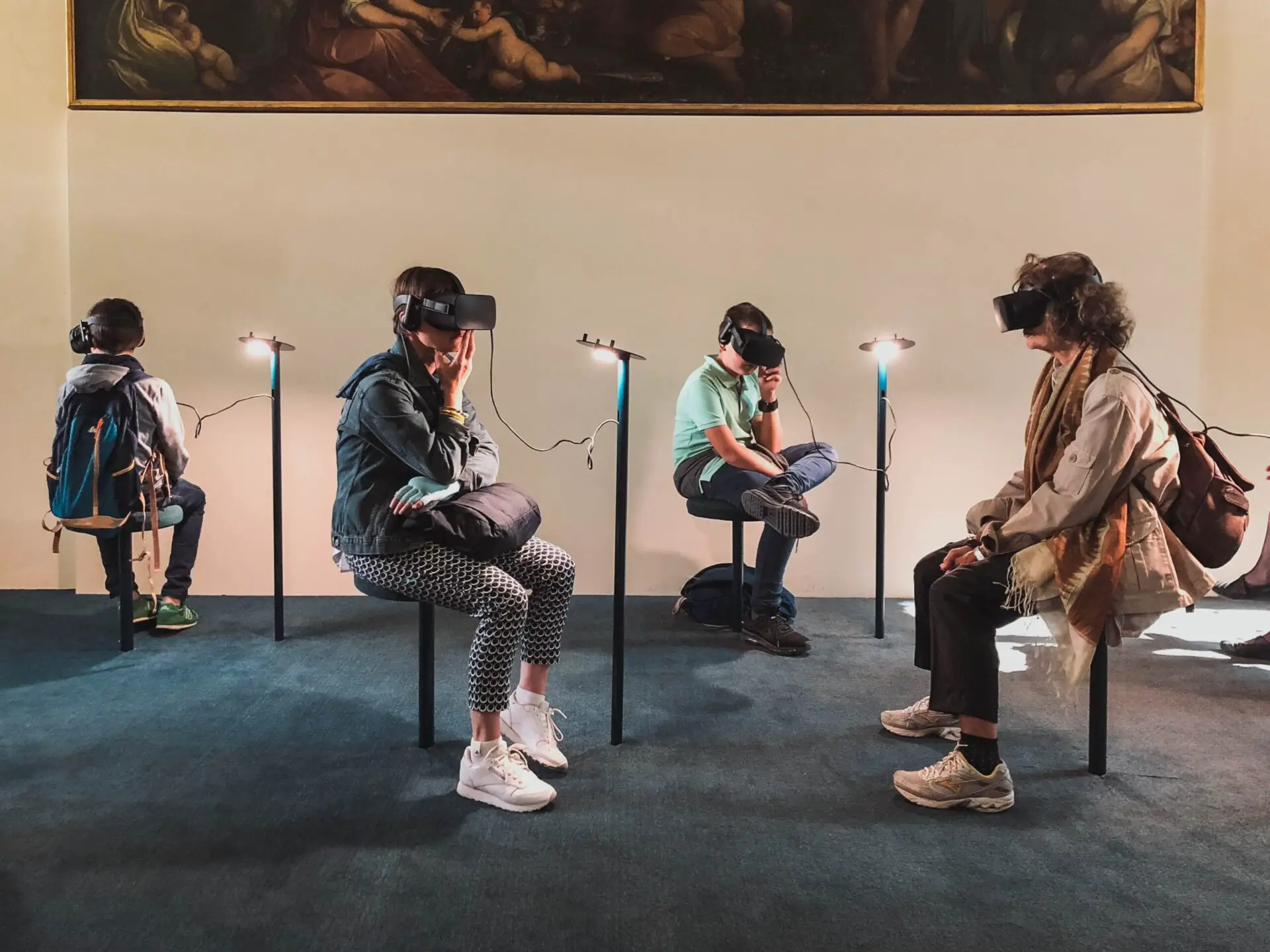As we enter into a new era of virtual reality, there are endless opportunities for companies to advertise their products. With the metaverse, customers will be able to see products first hand before they buy them.
This is a huge advantage over traditional marketing forms. This will be incredibly disruptive to advertisement and marketing in the same way that the internet disrupted the business in the late 90s and early 2000s.
In this article, we analyze how the virtual reality advertising trend will impact the world.
Advantages of Metaverse Marketing vs Traditional Marketing
When it comes to metaverse marketing, there are many advantages that VR advertising has over traditional forms of marketing. For one, the immersive experience of virtual reality allows customers to be fully engaged with the product they're viewing.
They can explore every detail of it, which can help them make a more informed purchase decision. In addition, VR advertising is much more interactive than traditional ads.
Customers can test out products in virtual reality before buying them, which increases the chances that they'll make a purchase. Another major advantage of VR advertising is its ability to reach a global audience.
With the metaverse and virtual reality, companies will be able to market their products to consumers all over the world. This will open up new opportunities for businesses, and it will help them reach a larger audience than ever before.
Finally, VR advertising is more engaging and exciting than traditional ads. It's an immersive experience that customers are likely to remember, which can lead to better results for companies.
Overall, VR advertising offers many advantages over traditional marketing forms, and it's poised to become the dominant form of advertising in the metaverse.
How Companies Will Shift Their Marketing Strategies
Now that we've looked at the advantages of VR advertising, let's take a closer look at how companies will shift their marketing strategies in response to this new technology.
First of all, businesses will need to create virtual reality versions of their products. This will allow customers to view and interact with products in a virtual environment, which can increase the chances of making a purchase.
In addition, companies will need to make sure that their VR products are compatible with various virtual reality headsets and devices. Another major shift for businesses is how they approach advertising in metaverse games.
Businesses will have to find new ways of reaching players within these games, as traditional ads may not be effective here. It's difficult to predict exactly what this metaverse marketing strategy looks like at this point; however, it seems likely that there'll be some sort of meta-advertising system in place where companies pay game developers or metaverses creators directly for placing their ads inside these environments.
This could range from small text advertisements on billboards throughout an area to fully rendered images popping up on the screen when a player moves their headset towards certain objects.
It could also include placing virtual sample stands, where you can interact and see the product in more detail. The possibilities are endless.

A Virtual Reality Paradigm Shift
VR advertising will be the dominant form of metaverse marketing in the future, and companies that want to stay ahead need to start adapting now.
Businesses need to create virtual reality versions of their products, make sure that their VR products are compatible with various headsets and devices, and approach advertising in metaverse games in a new way.
Only then will they be able to fully capitalize on the potential of VR advertising. There are some clear consequences of this shift:
- VR advertising is more interactive than traditional ads
- Customers can test out products in virtual reality before buying them
- VR advertising offers many advantages over traditional marketing forms
- Businesses need to create virtual reality versions of their products
- Advertising needs to be approached in a fun and engaging way for it to be effective
Now that you understand how virtual reality ads can play a role in building your brand and gaining more revenue, it's time to explore the integrations of timeless marketing principles with the new emerging technology.
Where Is Their Attention Focused?
The early adopters of Google's paid search service benefited tremendously. Entrepreneurs like Gary Vee managed to observe that the attention was going towards the internet with Google being the primary guide to his family's wine store.
Through paid Google search ads he was able to gain what he calls "underpriced attention". This is essentially a term used to describe cheap advertising costs that are efficient in delivering a high return on investment.
When Facebook (now Meta) began its paid advertising service, early promoters on the social media website noticed that there was significant traffic of consumer attention.
With not much bidding competition, Facebook marketers were able to reap the rewards of being the first to enter this advertising market.
The Metaverse Will Not Be Any Different
Market research and advertising are the most important tools that businesses use to understand their target audience, or market, and then advertise products/services to them respectively.
As more and more consumers spend their time in the metaverse, marketing research teams will need to be able to gather the appropriate customer feedback needed to refine their product and define their brand.
We already have seen this begin to take form in the metaverse with VR chat. If you haven't heard of VR chat, it's a metaverse where users create/download avatars and communicate through text, voice or even hand gestures!
It is free to use and has been popularized by YouTubers like PewDiePie.
Influencer Marketing in the Metaverse
If you are a marketer, you should be familiar with how powerful influencer marketing can be to sell products and improve your brand image. Let's explore how you can leverage influencers that are ready to step into the metaverse.
The free-to-play game Fortnite created a virtual concert featuring cultural icons for the younger demographic like Travis Scott, Ariana Grande, and Marshmello. The concert was streamed to millions of viewers and helped promote the game in a new way.
Although these virtual events are not 100% immersive as the technology is still developing, it shows that investments from large companies are ready to step into the metaverse. They are bringing influencers and more attention to their virtual worlds. It also does not look like they are ready to slow down as they will continue with these types of events with 'The Soundwave Series'.
Even if customers aren't avid gamers, it draws the attention of the passionate fan bases of these musical artists. If they enjoyed the immersive experience, they might just end up staying as loyal Fortnite players.
Other Influencer Types Will Be a Part of Metaverse Marketing
Concerts have shown that they can successfully integrate musical influencers into their marketing strategy. This plays to both influencer marketing and 'sound marketing'. How can influencers make customers feel like they are a part of a community?
Imagine what it would be like if you are an avid boxer and can practice your punches by hitting pads held by a VR representation of your favorite boxer?
Sports influencers can be scaled as VR coaches for individuals looking to improve their technique or fitness. They will be able to hear realistic encouragement and when the metaverse combines with machine learning, it will be difficult to distinguish the difference.
Reality Labs (a meta-research company) is already creating VR gloves that will help you feel virtual objects, temperature, and textures through touch. This means you can feel resistance as you punch the pads, creating a more realistic experience.

An Immersive Experience to Integrate Into Virtual Lifestyles
Advertising to all five senses is a secret many of the best marketers keep to themselves. They already understood the importance of an immersive experience. This is why shopping malls will often have bakeries near the entrance to draw passing citizens into the building through a pleasant smell.
A common problem with e-commerce brands is the difficulty of letting customers experience how products feel. A great sales page can describe it in detail but the metaverse can allow customers to feel the texture of the product.
Although marketing to other senses through the metaverse is still early, researchers and engineers are working hard to make this happen. Lifestyle brands can be creative in their approach as the metaverse has the potential to unlock new opportunities in marketing methods.
The metaverse is a gamechanger for marketers that understands the power of advertising to all the human senses. When the metaverse becomes truly immersive, marketing to the senses will become easier.
Building Brand Presence in Games
Finding the correct market demographic can be a challenge for companies. In the metaverse, this will become even more complex as virtual reality (VR) advertising becomes more prevalent. To date, metaverse games have mostly been of the fantasy or sci-fi genre, but with VR technology advancing and metaverses becoming more realistic, it's only a matter of time before we see products being advertised in games.
The metaverse offers unique opportunities for companies to advertise their products. For example, in a metaverse game like Second Life, companies can create virtual representations of their products that players can interact with. This would give players a better understanding of the product and could potentially increase sales.
Imagine that you are playing chess within the metaverse and on each chessboard, there is a logo of a chessboard manufacturer. This builds brand presence and can help create familiarity for purchases in the real world.
If chess is not your ideal type of game, don't worry because game development is growing fast with cost-efficient software from companies like Unity and Unreal Engine. This is making realistic game creation easier than ever and even smaller teams with a low budget can create incredible gaming experiences.
Game Development Is on the Rise
"We estimate that video game content and services will grow at a 15% compound annual growth rate from roughly $200 billion in 2021 to more than $400 billion by 2026 with the rise of “virtual worlds.” - Ark Invest Big Ideas 2022
Ark’s latest performance might not be so encouraging, but there is no way to deny that virtual worlds will continue to be one of the biggest trends of this century.
Metaverse games like Sandbox allow creatives to build within the metaverse by offering currencies for purchases of virtual goods.
For example, if you are a real-estate developer you can advertise your creations in these metaverse games. The users can own these virtual assets. This will create an additional source of sales revenue both for you as primary sales and for the virtual landlords by renting the digital property to other sandbox players.
This product placement advertising can help build your brand recognition for when this audience is ready to buy real estate in the real world. Sandbox has attracted partners from the likes of cultural icon Snoop Dogg to sports brands like Adidas and even legacy game developers like Atari.
Creative marketers and innovative entrepreneurs have an opportunity to create fun experiences while advertising their brand or service.

Gamifying Your Marketing
As a marketer, you should know that boring advertising can sometimes annoy potential customers. This is especially true if the intention is just to sell something. If a brand can gamify its sales process, it can create a fun experience rather than a painful buying expense.
From old Atari games to Nintendo Wii motion systems, the developments have been a decade-long process. The metaverse isn't just a buzzword as the reality of VR is starting to become fully developed.
Games are associated with fun and nostalgia. You can create a semantic web connection (keep reading to learn about semantics) and link your brand to happiness and pleasure while stealthy advertising your brand name and products in a fun manner.
Nostalgia marketing is another powerful tool professional advertisers will use. Humans naturally tend to daydream about their past youthful selves and believe the past is better than how things are in the present.
The new immersive metaverse can be overwhelming for some users, but legacy brands such as Nintendo can use nostalgia to their benefit. Imagine being in a game where you hear Mario asking for your help to save Princess Peach. As you turn your head, you see your childhood friend the one and only Mario himself!
You go on adventures together where the metaverse Mario world shrinks as you get bigger after eating a mushroom or you feel the heat battling the big bad Bowser.
The possibilities are endless.
Imagine the legacy brand of Pokémon allowing for users to search and catch realistic Pokémon creatures in the metaverse. If a Pokémon was rare, developers could create a limited supply of an NFT to represent ownership of the scarce creature. These businesses were able to build legendary brands with 8-bit games.
Modern game developers can create a more immersive creative property and attach NFTs as asset ownership into the world.
NFT Ownership Builds a Strong Brand Connection
Customers place more value in the products and items they can officially own. Items that are seen as status symbols can be sold at high prices demanding a large profit margin. NFT ownership allows for digital certification of the in-game items.
Applying the concept of marketing items as a social status works for the metaverse in the same way. Users can show off their rare metaverse property and items.
NFTs can be used as metaverse real estate, virtual ownership of metaverses, and even metaverse fashion. These concepts are brand-new to our current reality but will become more common as the metaverse becomes mainstream.
Nike Just Did It
They've stepped into this world by acquiring NFT innovators RTFKT 'artifact'. Teaming up with Nike, this young company is now in the running of becoming a top metaverse brand.
They are currently focused on AR (augmented reality) but with help of the legacy sports company trailblazer, the potential for historic marketing campaigns is limitless. Nike has a history of pushing the boundaries of sports and metaverse marketing is no different.
Scarcity in the Metaverse
The most common and well-known marketing strategy is to use scarcity to increase the demand and value of a product. Metaverse marketers can use scarcity with NFT releases that create a VIP community.
For example, a metaverse product or item can be sold as a limited release with only one NFT being available. Only the owner of that NFT would be able to sell or trade it.
This could create a frenzy with metaverse users as they scramble to try and buy the limited product. The product can only be used in the metaverse and cannot be taken out of the virtual world. This gives companies a way to keep tight control of the virtual assets they create.
One of the challenges for metaverse marketers will be to come up with creative ways to use scarcity. Most products in the metaverse will be digital and can easily be replicated. This means that companies must come up with unique ideas to make their products scarce. This is where NFTs can benefit marketers using scarcity.
Can Influential Entrepreneurs Build Virtual Communities?
This strategy has already been implemented by trend spotter Gary Vee and his NFTs (VeeFriends). Owning a digital representation of his characters that can't be counterfeited thanks to blockchain technology.
This allows owners of VeeFriends NFTs to gain real-world benefits such as video calls, physical meetings, and access to his conventions.
It would not be surprising to see him build upon his community by offering metaverse events where only NFT owners can enter, creating an exclusive experience.
The popular entrepreneur could also bring his intellectual property to life by making VR versions of them that express their programmed personalities. It would be like creating a Disney Land without having to physically build rides or train employees to play the role of the characters.
Long-distance community building
Marketers know the power of communities. This plays to social proof and word-of-mouth marketing. Leveraging social media with micro-influencers and megastars has helped new brands scale quickly in multiple markets with communities connecting all across the globe.
The metaverse will release the potential of community advertising by providing a new level of immersion. The metaverse can be used to connect people from different parts of the world in more meaningful ways than social media ever could. A metaverse can be used to create exciting new connections between community members, influencers, and brands.
Two fans of a brand or influencer on opposite sides of the world can now be together enjoying the brand's event. They can dance together, share drinks, listen to the same music, and they don't even have to dress up as they buy designer products for their digital avatars.
Selling Physical Products vs Selling VR Products
In this metaverse, there are already metaverse shops where users can purchase metaverse clothing for their avatars. Many online games are now moving to a free-to-play model. This means that the game itself costs nothing to play and attracts a large following due to the low barrier to entry.
The game companies earn money by selling digital assets such as costumes for their avatar or rare items like armor, weapons, housing, etc. The metaverse will be no different. It could potentially amplify this business model as users can enter a virtual world and immediately start spending money.
Advertisers will have a field day with metaverse products as they can be used to directly target customers in VR. The cost of creating these digital assets is often much less than the COGS (cost of goods sold) for real-world items.
Two Types of Virtual Ads
The metaverse will create endless opportunities for virtual reality advertising, and marketers that keep up with the latest marketing trends will be able to reap the rewards immensely! To advertise in virtual reality, we first need to understand how it works.
VR advertising can be broken down into two main categories:
- In-world advertising
- Out-of-world advertising
In-world advertising
This is where an advertisement is placed in a virtual world and the user interacts with it. For example, if you were to walk past a car in VR chat, the car would be a static object that you can't interact with. However, if you walked into a virtual car showroom, you would be able to interact with the cars and even sit in them!
Out-of-world advertising
This is where an advertisement is placed outside of a virtual world. For example, imagine you are watching a VR movie on YouTube. While the video is playing, an advertisement for a new Samsung VR headset appears and you can click on it to direct you to a metaverse website where you can purchase the VR headset.
Out-of-world advertising is most likely going to be the primary type of metaverse advertising, as it will not distract users from their main activity such as playing a game or using social media.
VR advertisements can be targeted towards specific audiences based on their interests. For example, if you wanted to advertise a new car, you could target people who have previously shown an interest in cars.
VR advertisements can be interactive and engaging, which will encourage users to spend more time watching them.
Out-of-world VR advertising principles can be similar to social media ads in terms of the accuracy of targeting. The difference is that marketers can create a more engaging experience to sell their products.
By now you might be thinking that this all sounds interesting, in theory. You may have some questions about the probability of metaverse being a part of your marketing strategy. Or even coming to reality any time soon. Before we go into more detail on the ways the metaverse will open new opportunities, we will address some of these skeptical thoughts.

Addressing The Skeptics
“It’s Only for the Kids!”
Remember when Facebook was just for college kids? Well now it's seen as a platform for older folks as the youth of today have moved to TikTok. Some older adults are already starting to move to TikTok.
New technology and trends are usually popular among the youth first but will become adopted by adults only a few years later. This has been the case with most forms of technology from cars to the internet. The metaverse and virtual reality are no exception.
Due to this trend, many skeptics believe that virtual reality advertising will not be adopted by adults. They argue that since older generations didn't grow up with metaverse technology, they will never be able to adapt to it.
There is a big difference between whether you can use metaverse technology and whether you will. Most people do not know how the internet works but still use it regularly.
When metaverse advertising becomes popular, older generations will likely use metaverse platforms since they are now using social media. Metaverse advertising will most likely be popular on these platforms and integrate itself seamlessly.
The metaverse can be scary to skeptics, as people fear the amount of attention and time we will spend within it.
However, there already are positive use cases for senior citizens. VR representations of real-world places allow them to travel all over the world while still being in the safety of their homes or facilities. It wouldn't be surprising for elders to begin seeing senior citizen home ads or medical alert system branding on these VR travels.
The Technology Isn’t Ready
"Now that consumers are spending more time and resources online, the importance of digital assets is likely to increase considerably as consumer spending shifts to virtual worlds" - ARK Invest
Whether you agree with Cathie Wood’s decisions in investing in innovation or not, it's difficult to deny that the technology is evolving quickly alongside consumer demand and acceptance.
Metaverse Moore's Law
The metaverse industry is growing so fast because it's following the same trend that other technologies have followed. It's been dubbed 'Moores Law for VR' which is the observation that VR technology improves exponentially over time.
The first Moore's Law was about transistors and how they double in power every two years. VR is following a similar path and the metaverse will grow exponentially as well.
Even though the complete technology of the metaverse isn't quite ready yet, understanding how fast technology develops will benefit you as a marketer. Metaverse marketing might just be here faster than you expect.
The future is here and it's time to connect more advertising ideas within the metaverse using semantic webs.
Semantic Advertising In The Metaverse
When you think of 'Nike', you might also immediately think of words such as 'inspiration' or 'athlete'. 'Whole Foods' is often instantly connected with 'healthy'.
The semantic web is a connection to other words back to your brand name. In simple terms, they are what customers associate with a brand.
As a brand begins to build or advertise in the metaverse, a connection can be made with words like 'innovative' and 'trendsetter'. Let's dive deeper into how semantic marketing can be applied within the metaverse.
Example: A Luxury Swimsuit Brand (E-Commerce)
Imagine a brand that wants to establish semantic webs with words like 'luxury' or 'clean oceans'.
Traditionally they can advertise through visuals to create this association.
Through advertising to all the senses in the metaverse, a brand can create a pop-up shop on the beach that allows for people to smell the ocean, feel the luxury material, and even hear compliments from a luxury influencer on how that item would look amazing on them.
An immersive metaverse experience allows brands to manufacture the exact setting they would like, allowing for control of the perfect semantic web.
Many grocery stores are already doing this in the real world. Marketers will use chalkboards with prices on them (often not real chalk) to show a natural community/farmers market or wooden crates stacked by the entrance to show the vegetables are freshly picked.
Creating a positive semantic web is nothing new. The metaverse unlocks the potential for marketers to bring this marketing tactic to the next level.
A Meta-Analysis of Advertising Disruption
Meta, formally known as Facebook, is leading the way for marketers to begin advertising in the metaverse. With a bold brand name change, this signifies their commitment to contributing to the creation of the metaverse.
As a company that makes profits on collecting data of its free users and selling it to other businesses as a powerful analytical advertisement maker spot, they are already familiar with this business model.
Meta can become the bridge for social media marketers to transition into Meta marketers. However, Meta is much more immersive than the old 'Facebook' and other social media sites.
Advertisers will need to take into account not only the user’s environment but also the user’s avatar. Having a natively social company, driven by advertising deals with marketers entering into the metaverse is a clear indicator that VR ads are on the way.
The Evolution of Technology and Marketing
Advertising has been around throughout history. Those that ignored the printing press lost their opportunities to the earliest form of flier ads. Those who ignored the radio missed out on radio ads. And those that ignored television, missed out on TV commercials.
The metaverse will be no different.
There will be metaverse ads, metaverse marketing, and metaverse companies focused on advertising in VR. If you missed the early opportunity with Facebook ads, you may have the ability to redeem another chance with Meta ads.
Conclusion
Technology and the VR world are moving fast. It can be daunting to move with it. As a marketer, anchoring yourself with timeless marketing principles will help prevent you from being lost in the metaverse.
The metaverse is a concept that is quickly becoming a reality and there are little to no barriers to what's possible. Do not become a victim of paralysis by analysis. Become optimistic in how you might have discovered a way to take advantage of this technology as a marketer or business owner.
You do not need to dive all in and bet everything on the metaverse if you are still skeptical. This article is an observation of what you can achieve as a marketer in the metaverse. The metaverse might just be a new passion you can immerse yourself in as an effective marketer.

